Business in Practice: Analysis of Tesco, Company Types, and Factors
VerifiedAdded on 2022/12/26
|9
|2601
|98
Report
AI Summary
This report provides a comprehensive overview of various business structures, including micro, small, medium, and large businesses, as well as different legal entities such as sole trader, partnership, limited liability, public limited liability, and cooperative. The report examines how internal and external factors impact business operations, with a specific focus on Tesco as a case study. It delves into organizational structures, such as hierarchical, matrix, functional, and geographic structures, and their effects on productivity. Furthermore, the report utilizes PESTLE and SWOT analyses to evaluate the influence of political, economic, social, technological, legal, and environmental factors, as well as internal strengths, weaknesses, opportunities, and threats, on business performance. The analysis highlights the importance of strategic planning, organizational size, and managerial perceptions in determining a business's success.
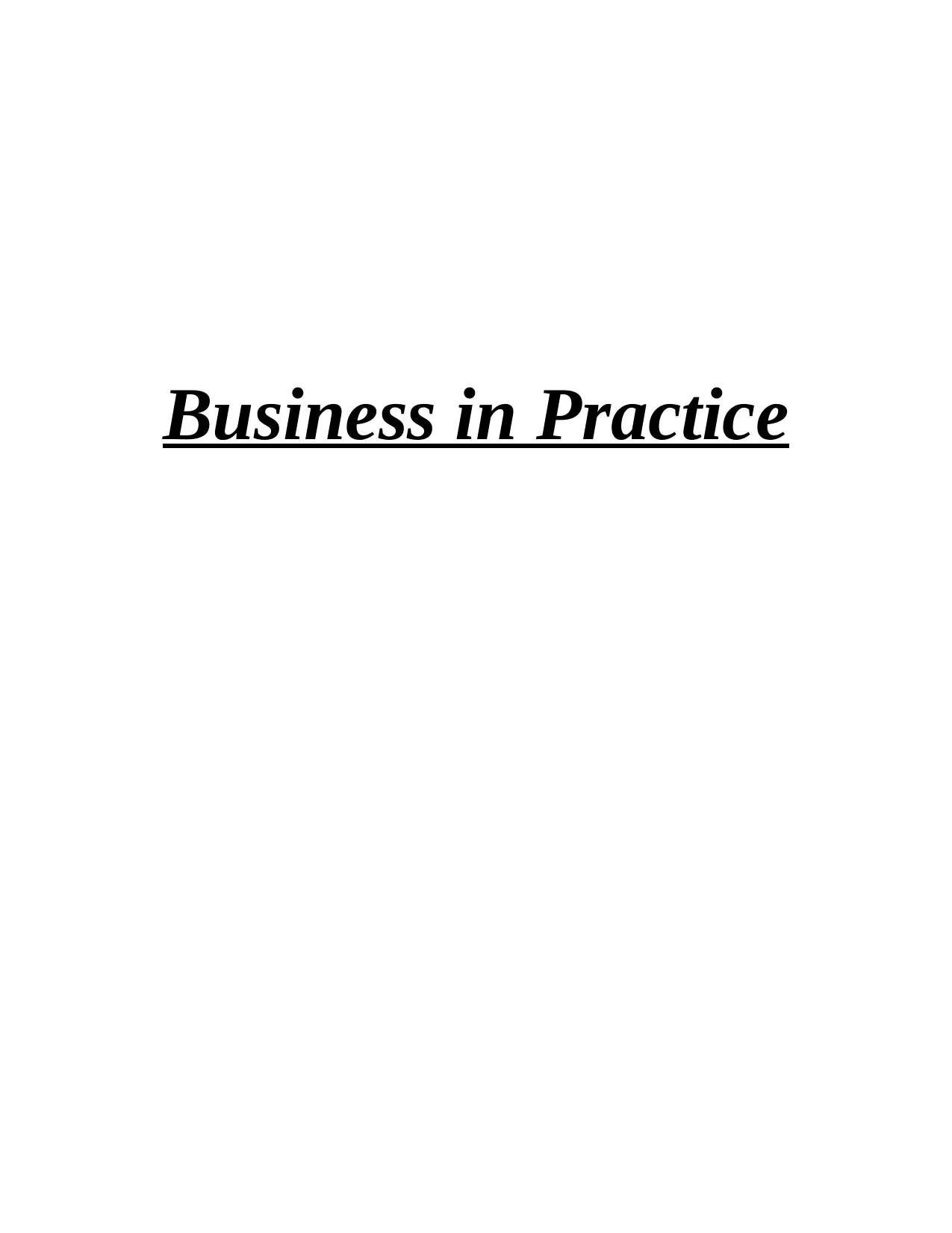
Business in Practice
Paraphrase This Document
Need a fresh take? Get an instant paraphrase of this document with our AI Paraphraser
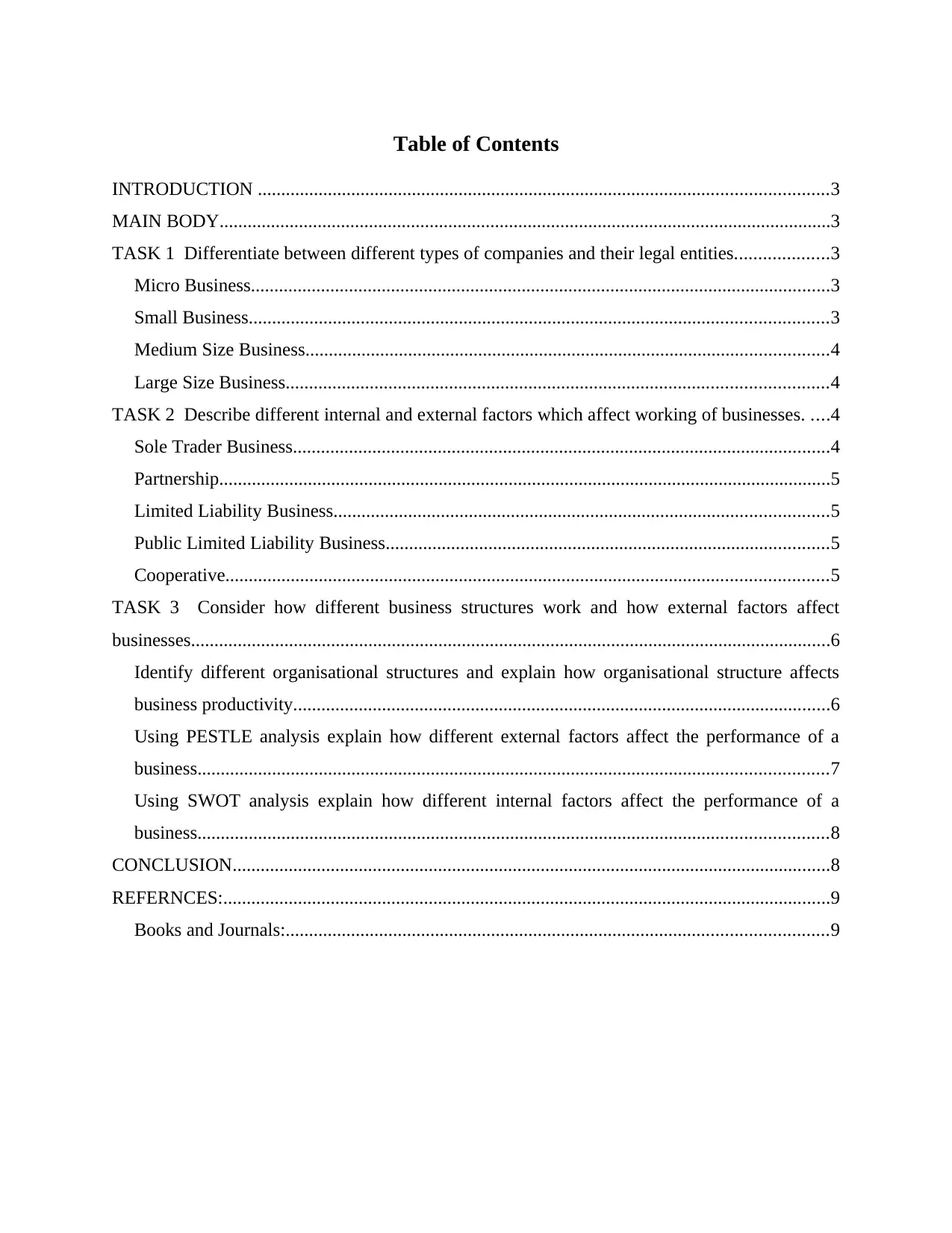
Table of Contents
INTRODUCTION ..........................................................................................................................3
MAIN BODY...................................................................................................................................3
TASK 1 Differentiate between different types of companies and their legal entities....................3
Micro Business............................................................................................................................3
Small Business............................................................................................................................3
Medium Size Business................................................................................................................4
Large Size Business....................................................................................................................4
TASK 2 Describe different internal and external factors which affect working of businesses. ....4
Sole Trader Business...................................................................................................................4
Partnership...................................................................................................................................5
Limited Liability Business..........................................................................................................5
Public Limited Liability Business...............................................................................................5
Cooperative.................................................................................................................................5
TASK 3 Consider how different business structures work and how external factors affect
businesses.........................................................................................................................................6
Identify different organisational structures and explain how organisational structure affects
business productivity...................................................................................................................6
Using PESTLE analysis explain how different external factors affect the performance of a
business.......................................................................................................................................7
Using SWOT analysis explain how different internal factors affect the performance of a
business.......................................................................................................................................8
CONCLUSION................................................................................................................................8
REFERNCES:..................................................................................................................................9
Books and Journals:....................................................................................................................9
INTRODUCTION ..........................................................................................................................3
MAIN BODY...................................................................................................................................3
TASK 1 Differentiate between different types of companies and their legal entities....................3
Micro Business............................................................................................................................3
Small Business............................................................................................................................3
Medium Size Business................................................................................................................4
Large Size Business....................................................................................................................4
TASK 2 Describe different internal and external factors which affect working of businesses. ....4
Sole Trader Business...................................................................................................................4
Partnership...................................................................................................................................5
Limited Liability Business..........................................................................................................5
Public Limited Liability Business...............................................................................................5
Cooperative.................................................................................................................................5
TASK 3 Consider how different business structures work and how external factors affect
businesses.........................................................................................................................................6
Identify different organisational structures and explain how organisational structure affects
business productivity...................................................................................................................6
Using PESTLE analysis explain how different external factors affect the performance of a
business.......................................................................................................................................7
Using SWOT analysis explain how different internal factors affect the performance of a
business.......................................................................................................................................8
CONCLUSION................................................................................................................................8
REFERNCES:..................................................................................................................................9
Books and Journals:....................................................................................................................9
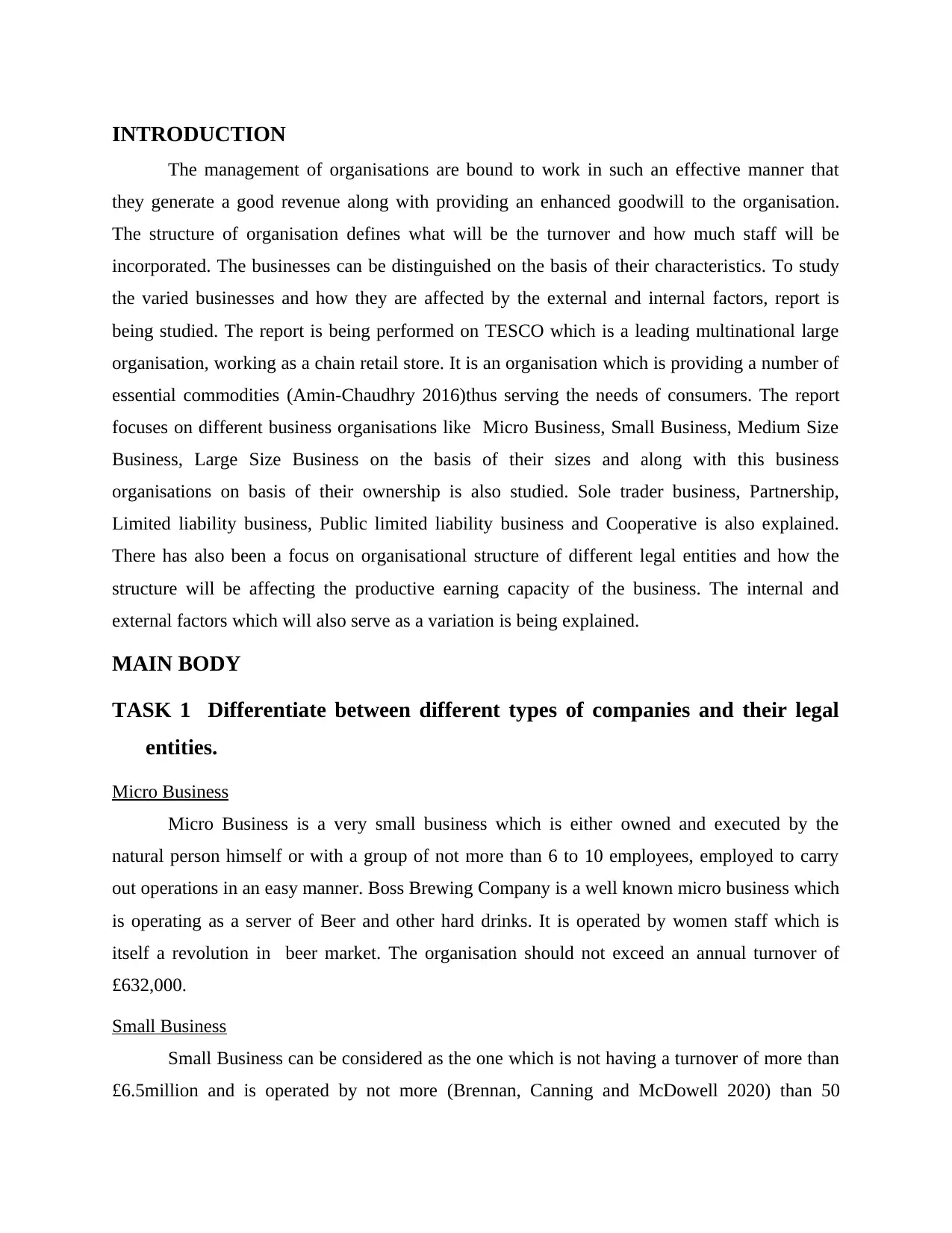
INTRODUCTION
The management of organisations are bound to work in such an effective manner that
they generate a good revenue along with providing an enhanced goodwill to the organisation.
The structure of organisation defines what will be the turnover and how much staff will be
incorporated. The businesses can be distinguished on the basis of their characteristics. To study
the varied businesses and how they are affected by the external and internal factors, report is
being studied. The report is being performed on TESCO which is a leading multinational large
organisation, working as a chain retail store. It is an organisation which is providing a number of
essential commodities (Amin-Chaudhry 2016)thus serving the needs of consumers. The report
focuses on different business organisations like Micro Business, Small Business, Medium Size
Business, Large Size Business on the basis of their sizes and along with this business
organisations on basis of their ownership is also studied. Sole trader business, Partnership,
Limited liability business, Public limited liability business and Cooperative is also explained.
There has also been a focus on organisational structure of different legal entities and how the
structure will be affecting the productive earning capacity of the business. The internal and
external factors which will also serve as a variation is being explained.
MAIN BODY
TASK 1 Differentiate between different types of companies and their legal
entities.
Micro Business
Micro Business is a very small business which is either owned and executed by the
natural person himself or with a group of not more than 6 to 10 employees, employed to carry
out operations in an easy manner. Boss Brewing Company is a well known micro business which
is operating as a server of Beer and other hard drinks. It is operated by women staff which is
itself a revolution in beer market. The organisation should not exceed an annual turnover of
£632,000.
Small Business
Small Business can be considered as the one which is not having a turnover of more than
£6.5million and is operated by not more (Brennan, Canning and McDowell 2020) than 50
The management of organisations are bound to work in such an effective manner that
they generate a good revenue along with providing an enhanced goodwill to the organisation.
The structure of organisation defines what will be the turnover and how much staff will be
incorporated. The businesses can be distinguished on the basis of their characteristics. To study
the varied businesses and how they are affected by the external and internal factors, report is
being studied. The report is being performed on TESCO which is a leading multinational large
organisation, working as a chain retail store. It is an organisation which is providing a number of
essential commodities (Amin-Chaudhry 2016)thus serving the needs of consumers. The report
focuses on different business organisations like Micro Business, Small Business, Medium Size
Business, Large Size Business on the basis of their sizes and along with this business
organisations on basis of their ownership is also studied. Sole trader business, Partnership,
Limited liability business, Public limited liability business and Cooperative is also explained.
There has also been a focus on organisational structure of different legal entities and how the
structure will be affecting the productive earning capacity of the business. The internal and
external factors which will also serve as a variation is being explained.
MAIN BODY
TASK 1 Differentiate between different types of companies and their legal
entities.
Micro Business
Micro Business is a very small business which is either owned and executed by the
natural person himself or with a group of not more than 6 to 10 employees, employed to carry
out operations in an easy manner. Boss Brewing Company is a well known micro business which
is operating as a server of Beer and other hard drinks. It is operated by women staff which is
itself a revolution in beer market. The organisation should not exceed an annual turnover of
£632,000.
Small Business
Small Business can be considered as the one which is not having a turnover of more than
£6.5million and is operated by not more (Brennan, Canning and McDowell 2020) than 50
⊘ This is a preview!⊘
Do you want full access?
Subscribe today to unlock all pages.

Trusted by 1+ million students worldwide
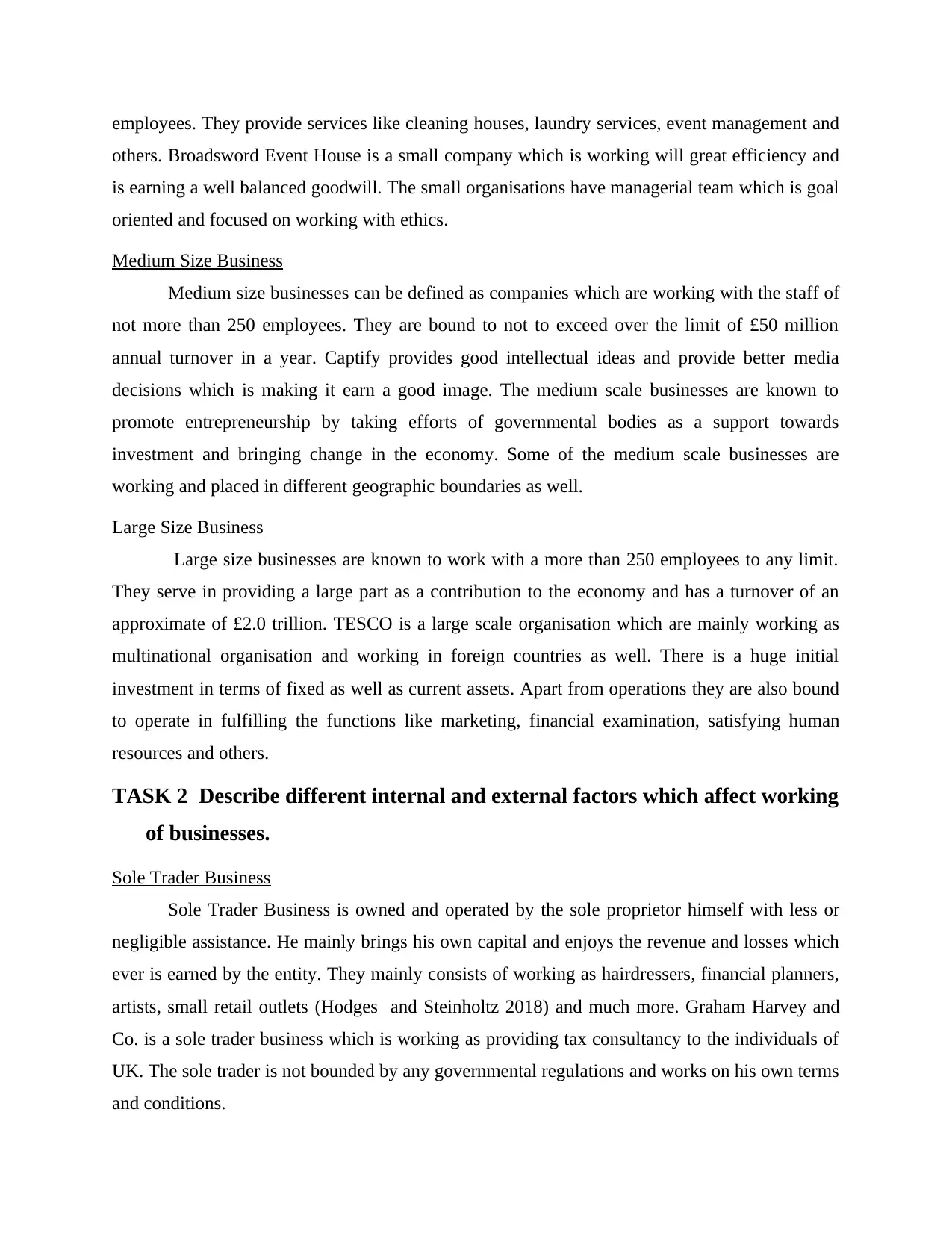
employees. They provide services like cleaning houses, laundry services, event management and
others. Broadsword Event House is a small company which is working will great efficiency and
is earning a well balanced goodwill. The small organisations have managerial team which is goal
oriented and focused on working with ethics.
Medium Size Business
Medium size businesses can be defined as companies which are working with the staff of
not more than 250 employees. They are bound to not to exceed over the limit of £50 million
annual turnover in a year. Captify provides good intellectual ideas and provide better media
decisions which is making it earn a good image. The medium scale businesses are known to
promote entrepreneurship by taking efforts of governmental bodies as a support towards
investment and bringing change in the economy. Some of the medium scale businesses are
working and placed in different geographic boundaries as well.
Large Size Business
Large size businesses are known to work with a more than 250 employees to any limit.
They serve in providing a large part as a contribution to the economy and has a turnover of an
approximate of £2.0 trillion. TESCO is a large scale organisation which are mainly working as
multinational organisation and working in foreign countries as well. There is a huge initial
investment in terms of fixed as well as current assets. Apart from operations they are also bound
to operate in fulfilling the functions like marketing, financial examination, satisfying human
resources and others.
TASK 2 Describe different internal and external factors which affect working
of businesses.
Sole Trader Business
Sole Trader Business is owned and operated by the sole proprietor himself with less or
negligible assistance. He mainly brings his own capital and enjoys the revenue and losses which
ever is earned by the entity. They mainly consists of working as hairdressers, financial planners,
artists, small retail outlets (Hodges and Steinholtz 2018) and much more. Graham Harvey and
Co. is a sole trader business which is working as providing tax consultancy to the individuals of
UK. The sole trader is not bounded by any governmental regulations and works on his own terms
and conditions.
others. Broadsword Event House is a small company which is working will great efficiency and
is earning a well balanced goodwill. The small organisations have managerial team which is goal
oriented and focused on working with ethics.
Medium Size Business
Medium size businesses can be defined as companies which are working with the staff of
not more than 250 employees. They are bound to not to exceed over the limit of £50 million
annual turnover in a year. Captify provides good intellectual ideas and provide better media
decisions which is making it earn a good image. The medium scale businesses are known to
promote entrepreneurship by taking efforts of governmental bodies as a support towards
investment and bringing change in the economy. Some of the medium scale businesses are
working and placed in different geographic boundaries as well.
Large Size Business
Large size businesses are known to work with a more than 250 employees to any limit.
They serve in providing a large part as a contribution to the economy and has a turnover of an
approximate of £2.0 trillion. TESCO is a large scale organisation which are mainly working as
multinational organisation and working in foreign countries as well. There is a huge initial
investment in terms of fixed as well as current assets. Apart from operations they are also bound
to operate in fulfilling the functions like marketing, financial examination, satisfying human
resources and others.
TASK 2 Describe different internal and external factors which affect working
of businesses.
Sole Trader Business
Sole Trader Business is owned and operated by the sole proprietor himself with less or
negligible assistance. He mainly brings his own capital and enjoys the revenue and losses which
ever is earned by the entity. They mainly consists of working as hairdressers, financial planners,
artists, small retail outlets (Hodges and Steinholtz 2018) and much more. Graham Harvey and
Co. is a sole trader business which is working as providing tax consultancy to the individuals of
UK. The sole trader is not bounded by any governmental regulations and works on his own terms
and conditions.
Paraphrase This Document
Need a fresh take? Get an instant paraphrase of this document with our AI Paraphraser
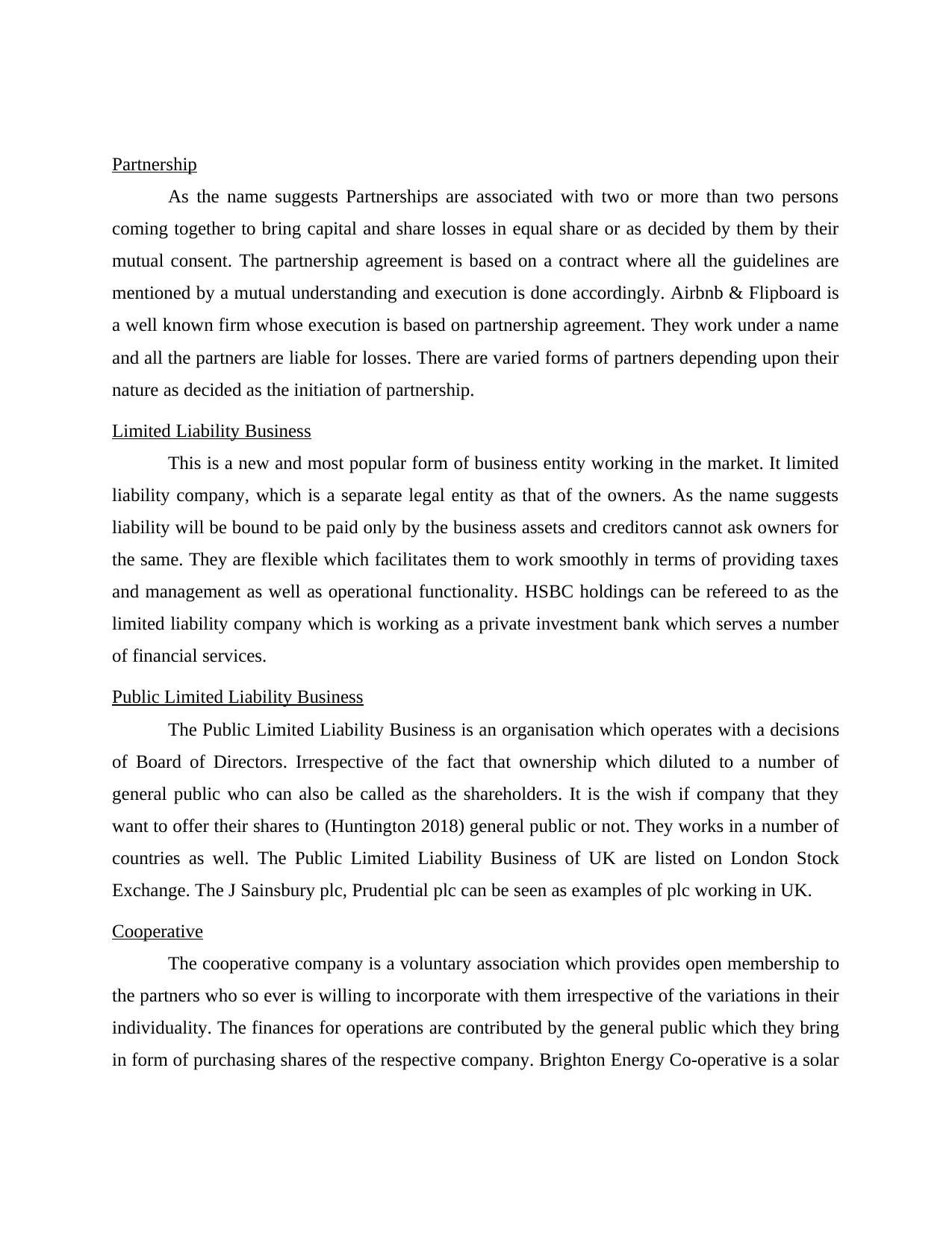
Partnership
As the name suggests Partnerships are associated with two or more than two persons
coming together to bring capital and share losses in equal share or as decided by them by their
mutual consent. The partnership agreement is based on a contract where all the guidelines are
mentioned by a mutual understanding and execution is done accordingly. Airbnb & Flipboard is
a well known firm whose execution is based on partnership agreement. They work under a name
and all the partners are liable for losses. There are varied forms of partners depending upon their
nature as decided as the initiation of partnership.
Limited Liability Business
This is a new and most popular form of business entity working in the market. It limited
liability company, which is a separate legal entity as that of the owners. As the name suggests
liability will be bound to be paid only by the business assets and creditors cannot ask owners for
the same. They are flexible which facilitates them to work smoothly in terms of providing taxes
and management as well as operational functionality. HSBC holdings can be refereed to as the
limited liability company which is working as a private investment bank which serves a number
of financial services.
Public Limited Liability Business
The Public Limited Liability Business is an organisation which operates with a decisions
of Board of Directors. Irrespective of the fact that ownership which diluted to a number of
general public who can also be called as the shareholders. It is the wish if company that they
want to offer their shares to (Huntington 2018) general public or not. They works in a number of
countries as well. The Public Limited Liability Business of UK are listed on London Stock
Exchange. The J Sainsbury plc, Prudential plc can be seen as examples of plc working in UK.
Cooperative
The cooperative company is a voluntary association which provides open membership to
the partners who so ever is willing to incorporate with them irrespective of the variations in their
individuality. The finances for operations are contributed by the general public which they bring
in form of purchasing shares of the respective company. Brighton Energy Co-operative is a solar
As the name suggests Partnerships are associated with two or more than two persons
coming together to bring capital and share losses in equal share or as decided by them by their
mutual consent. The partnership agreement is based on a contract where all the guidelines are
mentioned by a mutual understanding and execution is done accordingly. Airbnb & Flipboard is
a well known firm whose execution is based on partnership agreement. They work under a name
and all the partners are liable for losses. There are varied forms of partners depending upon their
nature as decided as the initiation of partnership.
Limited Liability Business
This is a new and most popular form of business entity working in the market. It limited
liability company, which is a separate legal entity as that of the owners. As the name suggests
liability will be bound to be paid only by the business assets and creditors cannot ask owners for
the same. They are flexible which facilitates them to work smoothly in terms of providing taxes
and management as well as operational functionality. HSBC holdings can be refereed to as the
limited liability company which is working as a private investment bank which serves a number
of financial services.
Public Limited Liability Business
The Public Limited Liability Business is an organisation which operates with a decisions
of Board of Directors. Irrespective of the fact that ownership which diluted to a number of
general public who can also be called as the shareholders. It is the wish if company that they
want to offer their shares to (Huntington 2018) general public or not. They works in a number of
countries as well. The Public Limited Liability Business of UK are listed on London Stock
Exchange. The J Sainsbury plc, Prudential plc can be seen as examples of plc working in UK.
Cooperative
The cooperative company is a voluntary association which provides open membership to
the partners who so ever is willing to incorporate with them irrespective of the variations in their
individuality. The finances for operations are contributed by the general public which they bring
in form of purchasing shares of the respective company. Brighton Energy Co-operative is a solar
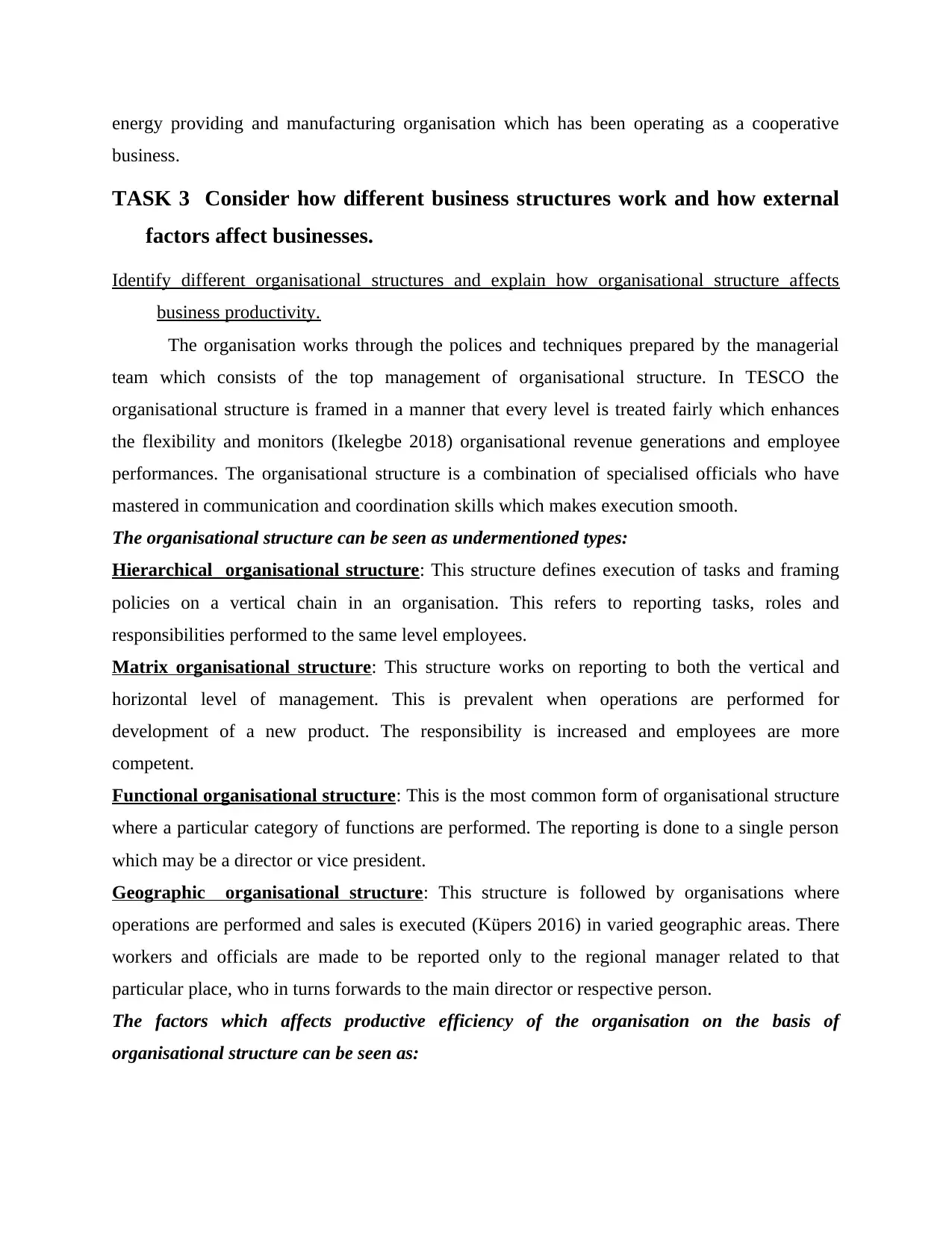
energy providing and manufacturing organisation which has been operating as a cooperative
business.
TASK 3 Consider how different business structures work and how external
factors affect businesses.
Identify different organisational structures and explain how organisational structure affects
business productivity.
The organisation works through the polices and techniques prepared by the managerial
team which consists of the top management of organisational structure. In TESCO the
organisational structure is framed in a manner that every level is treated fairly which enhances
the flexibility and monitors (Ikelegbe 2018) organisational revenue generations and employee
performances. The organisational structure is a combination of specialised officials who have
mastered in communication and coordination skills which makes execution smooth.
The organisational structure can be seen as undermentioned types:
Hierarchical organisational structure: This structure defines execution of tasks and framing
policies on a vertical chain in an organisation. This refers to reporting tasks, roles and
responsibilities performed to the same level employees.
Matrix organisational structure: This structure works on reporting to both the vertical and
horizontal level of management. This is prevalent when operations are performed for
development of a new product. The responsibility is increased and employees are more
competent.
Functional organisational structure: This is the most common form of organisational structure
where a particular category of functions are performed. The reporting is done to a single person
which may be a director or vice president.
Geographic organisational structure: This structure is followed by organisations where
operations are performed and sales is executed (Küpers 2016) in varied geographic areas. There
workers and officials are made to be reported only to the regional manager related to that
particular place, who in turns forwards to the main director or respective person.
The factors which affects productive efficiency of the organisation on the basis of
organisational structure can be seen as:
business.
TASK 3 Consider how different business structures work and how external
factors affect businesses.
Identify different organisational structures and explain how organisational structure affects
business productivity.
The organisation works through the polices and techniques prepared by the managerial
team which consists of the top management of organisational structure. In TESCO the
organisational structure is framed in a manner that every level is treated fairly which enhances
the flexibility and monitors (Ikelegbe 2018) organisational revenue generations and employee
performances. The organisational structure is a combination of specialised officials who have
mastered in communication and coordination skills which makes execution smooth.
The organisational structure can be seen as undermentioned types:
Hierarchical organisational structure: This structure defines execution of tasks and framing
policies on a vertical chain in an organisation. This refers to reporting tasks, roles and
responsibilities performed to the same level employees.
Matrix organisational structure: This structure works on reporting to both the vertical and
horizontal level of management. This is prevalent when operations are performed for
development of a new product. The responsibility is increased and employees are more
competent.
Functional organisational structure: This is the most common form of organisational structure
where a particular category of functions are performed. The reporting is done to a single person
which may be a director or vice president.
Geographic organisational structure: This structure is followed by organisations where
operations are performed and sales is executed (Küpers 2016) in varied geographic areas. There
workers and officials are made to be reported only to the regional manager related to that
particular place, who in turns forwards to the main director or respective person.
The factors which affects productive efficiency of the organisation on the basis of
organisational structure can be seen as:
⊘ This is a preview!⊘
Do you want full access?
Subscribe today to unlock all pages.

Trusted by 1+ million students worldwide
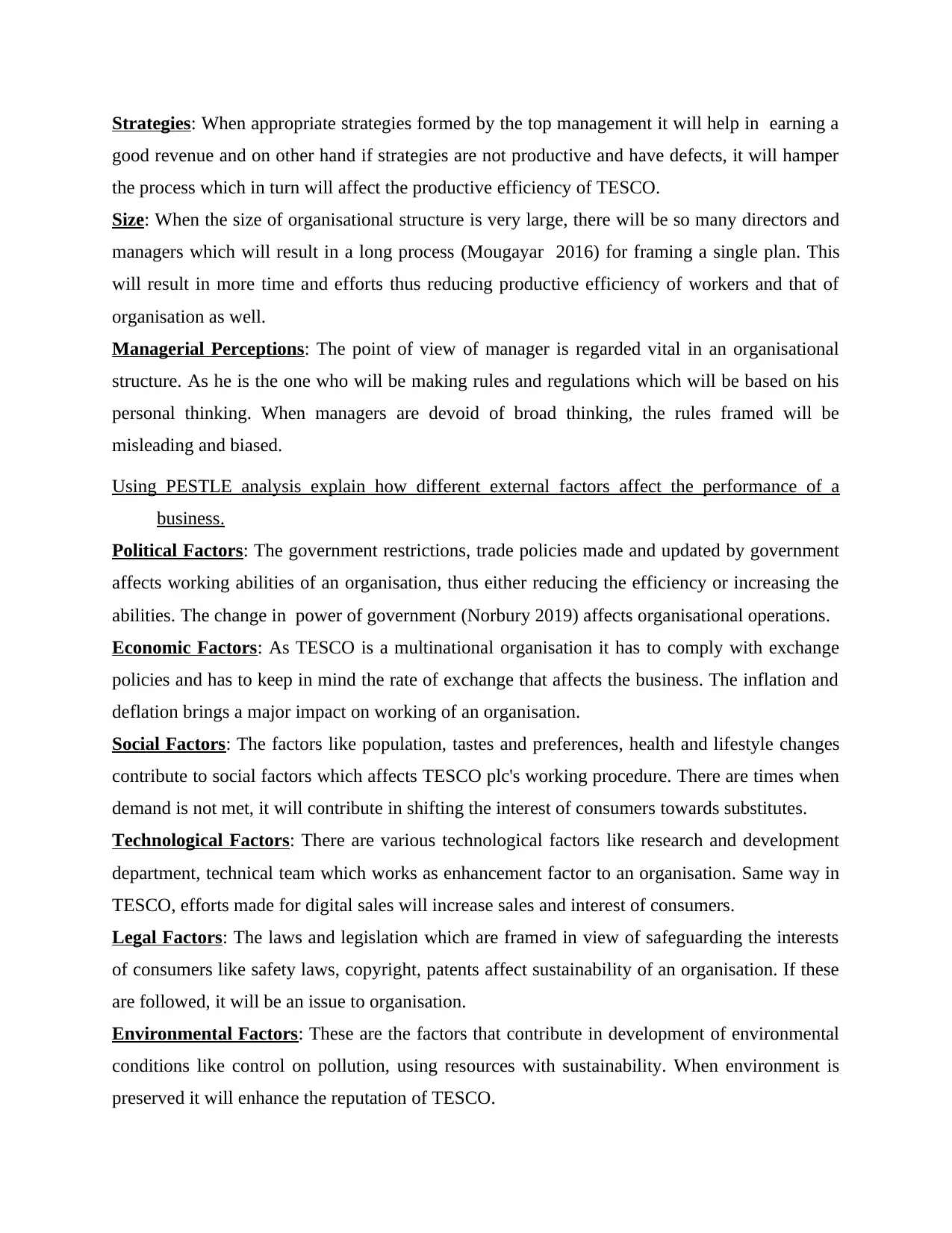
Strategies: When appropriate strategies formed by the top management it will help in earning a
good revenue and on other hand if strategies are not productive and have defects, it will hamper
the process which in turn will affect the productive efficiency of TESCO.
Size: When the size of organisational structure is very large, there will be so many directors and
managers which will result in a long process (Mougayar 2016) for framing a single plan. This
will result in more time and efforts thus reducing productive efficiency of workers and that of
organisation as well.
Managerial Perceptions: The point of view of manager is regarded vital in an organisational
structure. As he is the one who will be making rules and regulations which will be based on his
personal thinking. When managers are devoid of broad thinking, the rules framed will be
misleading and biased.
Using PESTLE analysis explain how different external factors affect the performance of a
business.
Political Factors: The government restrictions, trade policies made and updated by government
affects working abilities of an organisation, thus either reducing the efficiency or increasing the
abilities. The change in power of government (Norbury 2019) affects organisational operations.
Economic Factors: As TESCO is a multinational organisation it has to comply with exchange
policies and has to keep in mind the rate of exchange that affects the business. The inflation and
deflation brings a major impact on working of an organisation.
Social Factors: The factors like population, tastes and preferences, health and lifestyle changes
contribute to social factors which affects TESCO plc's working procedure. There are times when
demand is not met, it will contribute in shifting the interest of consumers towards substitutes.
Technological Factors: There are various technological factors like research and development
department, technical team which works as enhancement factor to an organisation. Same way in
TESCO, efforts made for digital sales will increase sales and interest of consumers.
Legal Factors: The laws and legislation which are framed in view of safeguarding the interests
of consumers like safety laws, copyright, patents affect sustainability of an organisation. If these
are followed, it will be an issue to organisation.
Environmental Factors: These are the factors that contribute in development of environmental
conditions like control on pollution, using resources with sustainability. When environment is
preserved it will enhance the reputation of TESCO.
good revenue and on other hand if strategies are not productive and have defects, it will hamper
the process which in turn will affect the productive efficiency of TESCO.
Size: When the size of organisational structure is very large, there will be so many directors and
managers which will result in a long process (Mougayar 2016) for framing a single plan. This
will result in more time and efforts thus reducing productive efficiency of workers and that of
organisation as well.
Managerial Perceptions: The point of view of manager is regarded vital in an organisational
structure. As he is the one who will be making rules and regulations which will be based on his
personal thinking. When managers are devoid of broad thinking, the rules framed will be
misleading and biased.
Using PESTLE analysis explain how different external factors affect the performance of a
business.
Political Factors: The government restrictions, trade policies made and updated by government
affects working abilities of an organisation, thus either reducing the efficiency or increasing the
abilities. The change in power of government (Norbury 2019) affects organisational operations.
Economic Factors: As TESCO is a multinational organisation it has to comply with exchange
policies and has to keep in mind the rate of exchange that affects the business. The inflation and
deflation brings a major impact on working of an organisation.
Social Factors: The factors like population, tastes and preferences, health and lifestyle changes
contribute to social factors which affects TESCO plc's working procedure. There are times when
demand is not met, it will contribute in shifting the interest of consumers towards substitutes.
Technological Factors: There are various technological factors like research and development
department, technical team which works as enhancement factor to an organisation. Same way in
TESCO, efforts made for digital sales will increase sales and interest of consumers.
Legal Factors: The laws and legislation which are framed in view of safeguarding the interests
of consumers like safety laws, copyright, patents affect sustainability of an organisation. If these
are followed, it will be an issue to organisation.
Environmental Factors: These are the factors that contribute in development of environmental
conditions like control on pollution, using resources with sustainability. When environment is
preserved it will enhance the reputation of TESCO.
Paraphrase This Document
Need a fresh take? Get an instant paraphrase of this document with our AI Paraphraser
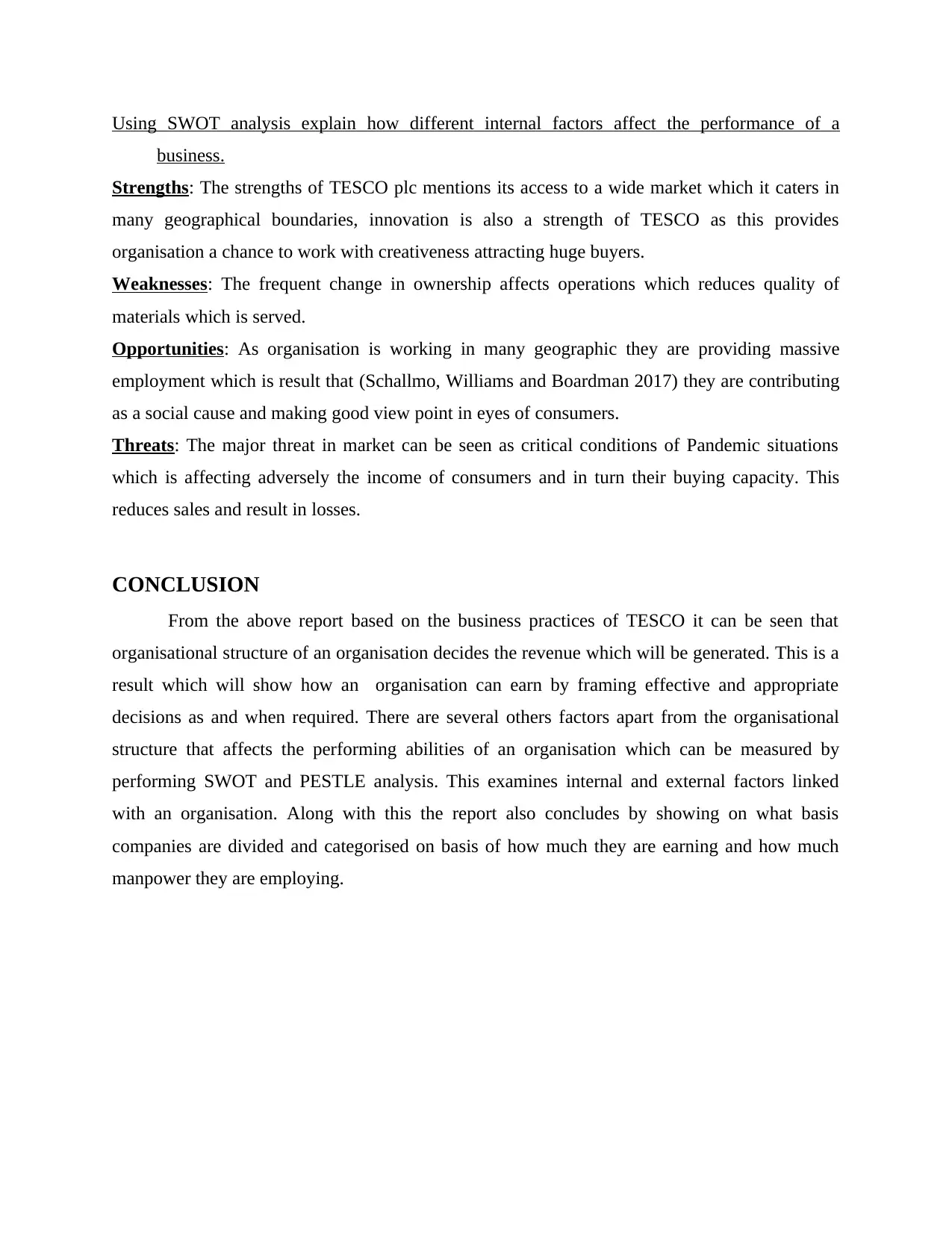
Using SWOT analysis explain how different internal factors affect the performance of a
business.
Strengths: The strengths of TESCO plc mentions its access to a wide market which it caters in
many geographical boundaries, innovation is also a strength of TESCO as this provides
organisation a chance to work with creativeness attracting huge buyers.
Weaknesses: The frequent change in ownership affects operations which reduces quality of
materials which is served.
Opportunities: As organisation is working in many geographic they are providing massive
employment which is result that (Schallmo, Williams and Boardman 2017) they are contributing
as a social cause and making good view point in eyes of consumers.
Threats: The major threat in market can be seen as critical conditions of Pandemic situations
which is affecting adversely the income of consumers and in turn their buying capacity. This
reduces sales and result in losses.
CONCLUSION
From the above report based on the business practices of TESCO it can be seen that
organisational structure of an organisation decides the revenue which will be generated. This is a
result which will show how an organisation can earn by framing effective and appropriate
decisions as and when required. There are several others factors apart from the organisational
structure that affects the performing abilities of an organisation which can be measured by
performing SWOT and PESTLE analysis. This examines internal and external factors linked
with an organisation. Along with this the report also concludes by showing on what basis
companies are divided and categorised on basis of how much they are earning and how much
manpower they are employing.
business.
Strengths: The strengths of TESCO plc mentions its access to a wide market which it caters in
many geographical boundaries, innovation is also a strength of TESCO as this provides
organisation a chance to work with creativeness attracting huge buyers.
Weaknesses: The frequent change in ownership affects operations which reduces quality of
materials which is served.
Opportunities: As organisation is working in many geographic they are providing massive
employment which is result that (Schallmo, Williams and Boardman 2017) they are contributing
as a social cause and making good view point in eyes of consumers.
Threats: The major threat in market can be seen as critical conditions of Pandemic situations
which is affecting adversely the income of consumers and in turn their buying capacity. This
reduces sales and result in losses.
CONCLUSION
From the above report based on the business practices of TESCO it can be seen that
organisational structure of an organisation decides the revenue which will be generated. This is a
result which will show how an organisation can earn by framing effective and appropriate
decisions as and when required. There are several others factors apart from the organisational
structure that affects the performing abilities of an organisation which can be measured by
performing SWOT and PESTLE analysis. This examines internal and external factors linked
with an organisation. Along with this the report also concludes by showing on what basis
companies are divided and categorised on basis of how much they are earning and how much
manpower they are employing.
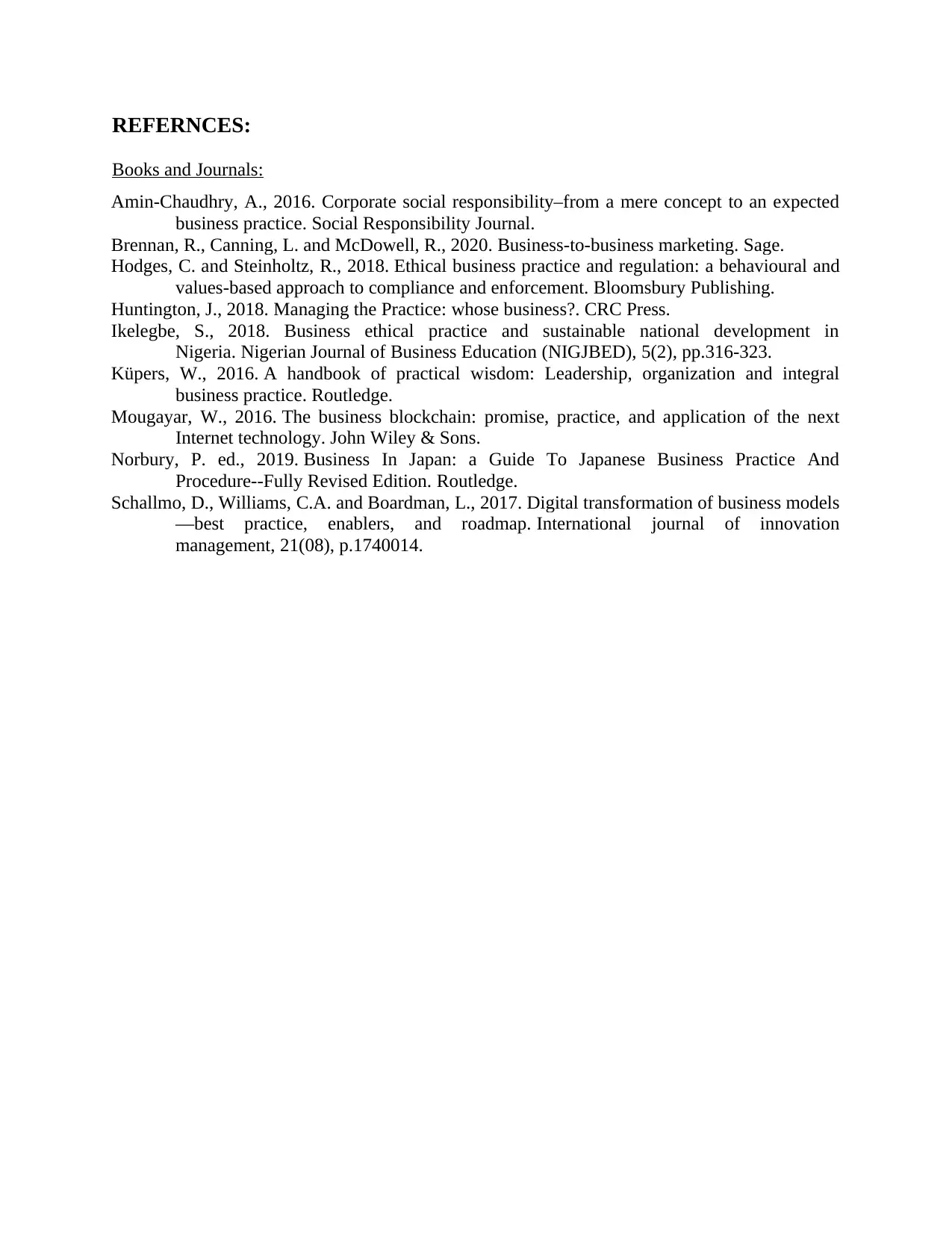
REFERNCES:
Books and Journals:
Amin-Chaudhry, A., 2016. Corporate social responsibility–from a mere concept to an expected
business practice. Social Responsibility Journal.
Brennan, R., Canning, L. and McDowell, R., 2020. Business-to-business marketing. Sage.
Hodges, C. and Steinholtz, R., 2018. Ethical business practice and regulation: a behavioural and
values-based approach to compliance and enforcement. Bloomsbury Publishing.
Huntington, J., 2018. Managing the Practice: whose business?. CRC Press.
Ikelegbe, S., 2018. Business ethical practice and sustainable national development in
Nigeria. Nigerian Journal of Business Education (NIGJBED), 5(2), pp.316-323.
Küpers, W., 2016. A handbook of practical wisdom: Leadership, organization and integral
business practice. Routledge.
Mougayar, W., 2016. The business blockchain: promise, practice, and application of the next
Internet technology. John Wiley & Sons.
Norbury, P. ed., 2019. Business In Japan: a Guide To Japanese Business Practice And
Procedure--Fully Revised Edition. Routledge.
Schallmo, D., Williams, C.A. and Boardman, L., 2017. Digital transformation of business models
—best practice, enablers, and roadmap. International journal of innovation
management, 21(08), p.1740014.
Books and Journals:
Amin-Chaudhry, A., 2016. Corporate social responsibility–from a mere concept to an expected
business practice. Social Responsibility Journal.
Brennan, R., Canning, L. and McDowell, R., 2020. Business-to-business marketing. Sage.
Hodges, C. and Steinholtz, R., 2018. Ethical business practice and regulation: a behavioural and
values-based approach to compliance and enforcement. Bloomsbury Publishing.
Huntington, J., 2018. Managing the Practice: whose business?. CRC Press.
Ikelegbe, S., 2018. Business ethical practice and sustainable national development in
Nigeria. Nigerian Journal of Business Education (NIGJBED), 5(2), pp.316-323.
Küpers, W., 2016. A handbook of practical wisdom: Leadership, organization and integral
business practice. Routledge.
Mougayar, W., 2016. The business blockchain: promise, practice, and application of the next
Internet technology. John Wiley & Sons.
Norbury, P. ed., 2019. Business In Japan: a Guide To Japanese Business Practice And
Procedure--Fully Revised Edition. Routledge.
Schallmo, D., Williams, C.A. and Boardman, L., 2017. Digital transformation of business models
—best practice, enablers, and roadmap. International journal of innovation
management, 21(08), p.1740014.
⊘ This is a preview!⊘
Do you want full access?
Subscribe today to unlock all pages.

Trusted by 1+ million students worldwide
1 out of 9
Related Documents
Your All-in-One AI-Powered Toolkit for Academic Success.
+13062052269
info@desklib.com
Available 24*7 on WhatsApp / Email
![[object Object]](/_next/static/media/star-bottom.7253800d.svg)
Unlock your academic potential
Copyright © 2020–2025 A2Z Services. All Rights Reserved. Developed and managed by ZUCOL.





